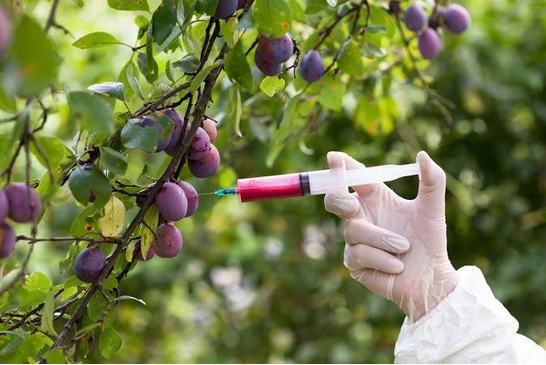
UNITED STATES—There are two main aspects of the GMO debate that are important: the science and the economics. The science is pretty straightforward: you go in and modify gene sequences in order to produce desirable characteristics. You can modify existing genes, or add genes from other sources. Sounds simple enough. The intention is not very different from what we have done for thousands of years by selective breeding and hybridization.
Potentially, GMO technology can achieve more radical changes, much faster. It is also sometimes possible to create new characteristics that would be extremely difficult, if not impossible, to accomplish in less than a few thousand generations by the old methods. One of the problems that some people have with GMOs is that the added genes can come from any source.
Animal genes can be mixed into plant DNA, and we don’t know what the long term consequences will be. The GMO developers believe that there will be no adverse consequences, but history shows us that adverse consequences can still happen even if you believe that they won’t; belief is not enough. DDT was not designed to kill birds, but it accidentally killed whole populations of birds.
Examples of our successful manipulation of organisms over thousands of years are all around us: apples bigger than walnuts, tomatoes with Samsonite skin, bananas with edible seeds, grapes with and without seeds, domesticated pigs, chickens that lay lots more eggs, wheat that returns 30 bushels an acre instead of 2, corn that can be eaten from the cob, and thousands of varieties of edible rice. With advances in genetic testing, scientists can now speed up this process by testing seeds as soon as they are produced to see if they have the desired characteristics instead of having to wait for a generation or two and observe if the change they wanted has actually happened. New varieties of GMOs can potentially develop very rapidly.
That is the very difficulty with GMOs: that the new methods of genetic manipulation can make whole new categories of consequences that were not possible by the old methods of selective breeding and hybridization. The first category of consequence people take issue with is creating plants that are resistant to specific pesticides and defoliants (Roundup Ready ® for example http://web.mit.edu/demoscience/Monsanto/about.html). If you have crops that can tolerate more of these poisons, you can use more poison to get a potentially higher crop yield.
This happens at the expense of having more of these poisons in the environment. By using more and more Roundup ®, we are also breeding super weeds that are Roundup ® resistant. We are not creating Roundup Ready ® bees, birds, fish, or people. We know that these poisons have disastrous effects on some wildlife: monarch butterflies are disappearing from their normal range; bees are dying by the billion, and most environmentalists assume that we will, in hindsight, be able to prove some pretty awful effects on people, too.
There are other ways to use the same technology to create a different type of organism, such as GMO pests that out-compete native pests, are eaten by the same predators, and do not attack our favorite crops. Unfortunately, these are products that are not directly linked to the potential sales increase of specific products. There is no direct profit to be made from developing this type of GMO.
Before we address the economics, there is, of course, another aspect of the science that needs to be addressed, The Frankenstein Effect. However you mess about with genetics through heredity and hybridization, you are fairly limited to a discrete set of outcomes. Usually it is intended to be an improvement, and if it isn’t, you can try again. But, you can’t breed a plant that has genes from a frog. With GMOs you have a whole new set of problems. It is possible to make organisms that may have very dangerous characteristics, by accident. Once the GMO product is on the market, these organisms can pass their potentially dangerous characteristics to natural populations.
In other words, we think we know what we’re doing, but in fact we’re messing around with things about which our understanding is, at best, incomplete.
Take for example what has been called the “terminator gene.” This was a GMO characteristic that was supposedly created by the Monsanto corporation. The way it worked was that seeds would sprout and do well, but only for a single generation. The seeds made by the plants grown from these seeds were not viable. They would not produce additional offspring.
This is great, if you sell seed. Your customers have to come back next year and buy all new seed from you. It is not so great for farmers who counted on buying only a part of their seeds every year, re-using some of the seeds from the plants they grew last year. You can see how this works.
Unfortunately, what if that gene gets loose in the general population of grasses? You can say it can’t happen, but what if it does? What makes you think that these characteristics can’t cross pollinate across varieties or species? Some varieties and species easily cross pollinate, that’s how we get hybrid seeds.
Just because you doubt something is true does not ensure that it won’t happen. Just because the manufacturer says that it can’t happen is no real guarantee that it will not happen. History has shown us time and time again that the representations of even well meaning people do not ensure that a product is good or safe, especially when enormous potential profit is involved.
Ultimately, the honest scientific response to the question of whether GMOs present a danger to human populations on Earth is: We don’t know. On the basis of current evidence, the risks may be quite small, if the implementation of GMOs is accomplished responsibly by people who know what they are doing. But, when have you known this to be the case when the only motivating factor is profit? And that leads us to the economics of GMOs.
We currently have a global economy that is driven by profit. This economy, according to the WHO, results in the starvation of millions of human beings every year. In simple terms, it is fairly easily demonstrable that all human starvation on this planet is artificial. That is to say that if the goal was to feed everyone, we would be able to do this. This is within our technical capability. However, it is currently true that to not do so, makes for a more profitable situation for some people. Those people control key commodity markets.
Commodity markets determine the price and availability of food for the lion’s share of the human population of planet Earth. It is deemed more important for these people to make a profit than for everyone to have enough food to survive.
Creating an economy that is based on GMOs concentrates the control of the source of foodstuffs in fewer hands. It allows a smaller number of people to control the global food supply. There are many economists who say that this is not a good idea. They say that this will inevitably lead to more starvation rather than less, simply because more starvation is more profitable.
Creating an economy that encourages locally grown food, biodiversity, and regionally appropriated crops results in a more sustainable food supply. It uses less pesticides and fertilizers, which is better for the environment. It will also result in lower profits for big, multinational agribusiness corporations.
Profit does not care about starving children. Profit is unaffected by the poverty and misery of millions. The argument against GMOs on economic grounds centers on the fact that a concentration of control of foodstuffs in a smaller group of profit-oriented corporations or individuals inevitably results in greater human misery and starvation.
It comes down to the kind of world you want to live in. Do you want to live in a world where the unlimited profit potential of any idea is allowed to result in the misery and starvation of millions of human beings or do you want to live in a world where every human being has a right to life, even if that constraint limits the profits of the richest, most powerful business interests.






